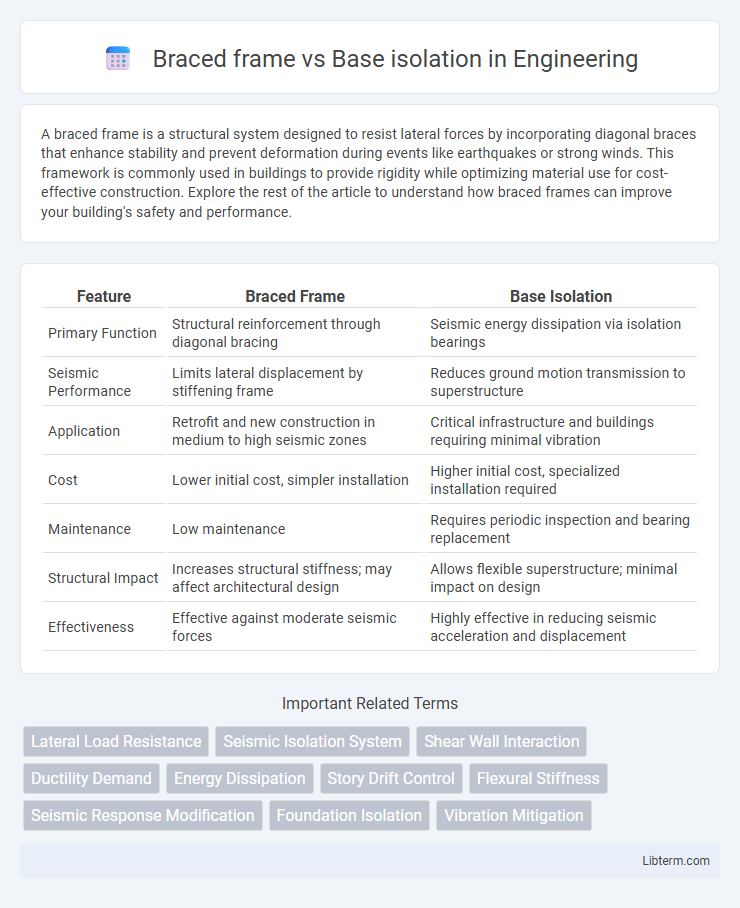A braced frame is a structural system designed to resist lateral forces by incorporating diagonal braces that enhance stability and prevent deformation during events like earthquakes or strong winds. This framework is commonly used in buildings to provide rigidity while optimizing material use for cost-effective construction. Explore the rest of the article to understand how braced frames can improve your building's safety and performance.
Table of Comparison
| Feature | Braced Frame | Base Isolation |
|---|---|---|
| Primary Function | Structural reinforcement through diagonal bracing | Seismic energy dissipation via isolation bearings |
| Seismic Performance | Limits lateral displacement by stiffening frame | Reduces ground motion transmission to superstructure |
| Application | Retrofit and new construction in medium to high seismic zones | Critical infrastructure and buildings requiring minimal vibration |
| Cost | Lower initial cost, simpler installation | Higher initial cost, specialized installation required |
| Maintenance | Low maintenance | Requires periodic inspection and bearing replacement |
| Structural Impact | Increases structural stiffness; may affect architectural design | Allows flexible superstructure; minimal impact on design |
| Effectiveness | Effective against moderate seismic forces | Highly effective in reducing seismic acceleration and displacement |
Introduction to Seismic Structural Systems
Braced frames provide lateral stability to buildings by incorporating diagonal supports that transfer seismic forces to the foundation, enhancing structural rigidity during earthquakes. Base isolation systems decouple the building from ground motion using flexible bearings, significantly reducing seismic energy transmitted to the structure. Both methods are critical seismic structural systems designed to mitigate earthquake damage but operate through fundamentally different mechanisms--bracing increases stiffness, while base isolation improves flexibility.
Understanding Braced Frames
Braced frames enhance structural stability by incorporating diagonal steel members that resist lateral forces from wind and seismic activity, providing rigidity and reducing building sway. These frames transfer loads directly to the foundation, making them cost-effective for mid-rise structures in seismic zones. Compared to base isolation, which decouples the building from ground motion, braced frames rely on internal stiffening for earthquake resistance.
Overview of Base Isolation Techniques
Base isolation techniques involve installing flexible bearings or isolators between a building's foundation and superstructure to decouple seismic forces and reduce structural vibrations during earthquakes. Common isolators include elastomeric bearings, sliding bearings, and hybrid systems designed to absorb and dissipate seismic energy effectively. This approach enhances building resilience by minimizing structural damage and protecting occupants, contrasting with braced frames which rely on stiffness and strength to resist seismic loads.
Key Differences Between Braced Frames and Base Isolation
Braced frames enhance structural stability by using diagonal braces to resist lateral forces, primarily improving a building's rigidity during earthquakes. Base isolation minimizes seismic impact by placing flexible bearings or isolators between the building and its foundation, allowing movement and reducing energy transfer. While braced frames concentrate on internal structural reinforcement, base isolation focuses on separating the structure from ground motion for superior seismic protection.
Structural Performance During Earthquakes
Braced frames provide lateral stiffness and energy dissipation by using diagonal steel members that resist seismic forces, enhancing a building's ability to withstand earthquake-induced lateral loads. Base isolation systems improve structural performance by decoupling the building from ground motion through flexible bearings, significantly reducing seismic acceleration and structural deformation. While braced frames increase structural strength, base isolation offers superior reduction in seismic forces and damage, making it highly effective for protecting sensitive or critical infrastructure.
Cost Analysis: Braced Frames vs Base Isolation
Braced frames generally offer a more cost-effective solution compared to base isolation, primarily due to lower initial construction expenses and simpler structural design requirements. Base isolation systems involve higher upfront costs driven by specialized materials, advanced technology for seismic damping, and more complex installation processes. Long-term benefits of base isolation, such as reduced repair costs and minimized downtime after earthquakes, may offset the initial investment depending on seismic risk and building use.
Installation Challenges and Considerations
Braced frame systems require precise alignment and connection of steel members, demanding skilled labor and careful sequencing to ensure structural integrity during installation. Base isolation involves installing specialized bearings and dampers between the building foundation and superstructure, necessitating detailed site preparation and coordination to accommodate equipment placement and load transfers. Both methods require thorough planning to address potential interference with existing utilities and ensure compliance with seismic design standards.
Maintenance and Longevity Comparison
Braced frames typically require regular inspections and maintenance to address potential corrosion, fatigue, and bolt loosening, which can impact their longevity over time. Base isolation systems, while initially more complex, generally demand less frequent maintenance due to their ability to absorb seismic energy and reduce structural stress, thereby enhancing overall durability. The longevity of base-isolated buildings often surpasses that of braced frame structures, as the isolation decreases wear and tear on critical components during earthquakes.
Suitable Applications for Each System
Braced frames are ideal for high-rise buildings and structures requiring increased lateral stiffness and strength in seismic zones due to their efficient load distribution and cost-effectiveness. Base isolation systems are best suited for critical infrastructure such as hospitals, museums, and historic buildings where minimizing seismic forces and structural damage is essential for preserving functionality and contents. Selecting between these systems depends on factors like building height, usage importance, and seismic risk level, with braced frames favoring taller, cost-sensitive projects and base isolation prioritizing protection and serviceability.
Future Trends in Seismic Protection Technologies
Future trends in seismic protection technologies emphasize the integration of smart materials and real-time monitoring systems with both braced frame and base isolation methods to enhance structural resilience. Advances in base isolation now include adaptive systems that adjust to seismic activity dynamically, providing superior energy dissipation compared to traditional designs. Braced frames are evolving with the incorporation of innovative dampers and high-performance alloys, improving their capacity to absorb shocks and reduce cumulative damage during earthquakes.
Braced frame Infographic

 libterm.com
libterm.com